Human Body and Its Movements
- Books Name
- Class 6 Science Book
- Publication
- PathSet Publications
- Course
- CBSE Class 6
- Subject
- Science
Our body is capable of performing a wide variety of simple and complex functions. It is able to do so because of the internal structure that facilitates its movement.
Locomotion: Movement of organisms from place to place.
Human Body and Its Movements
Locomotion
There are two kinds of movements:
- The organisms move their body parts without changing their position.
- Animals move from one place to another. This kind of movement is called locomotion.
The human skeleton is the internal framework which is responsible for giving support, shape and protection to our bodies. It contains 206 bones, each playing a distinct yet important task. The skeleton can be classified into two parts called as the axial and the appendicular. The axial skeleton comprises of the central part of the skull, spine, and ribs and the appendicular skeleton consists of the arms and legs.
Locomotion in human body:
(i) Human skeleton: It forms a framework that gives shape and support to the body.
It consists of 206 bones. It protects internal organs.
(a) Skull: It protect the brain. It is rigid box made up of plates of bone firmly
joined together.
(b) Rib cage: It is flexible case of ribs. Each rib curves round the side of the chest
from the backbone and is joined in front to a plate of bone called sternum. Ribs are connected to one another by the muscles. Two lower most pairs of ribs are called ‘floating ribs’.
(c) Backbone: It is also called the spine or vertebral column. It is a chain of small bones called vertebrae. It protects the spinal cord, which carries messages between the brain and body. It also supports the skull, ribs and limbs.
(d) Limbs: It is made up of long bones with joints that allows them to move. They are mainly for support.
Bones of hands and legs: Bones of arms, thighs, etc., are long. They give strength to our body. Bones of fingers and toes are short. They help us in holding things. The hands and legs are constructed in same pattern as described below
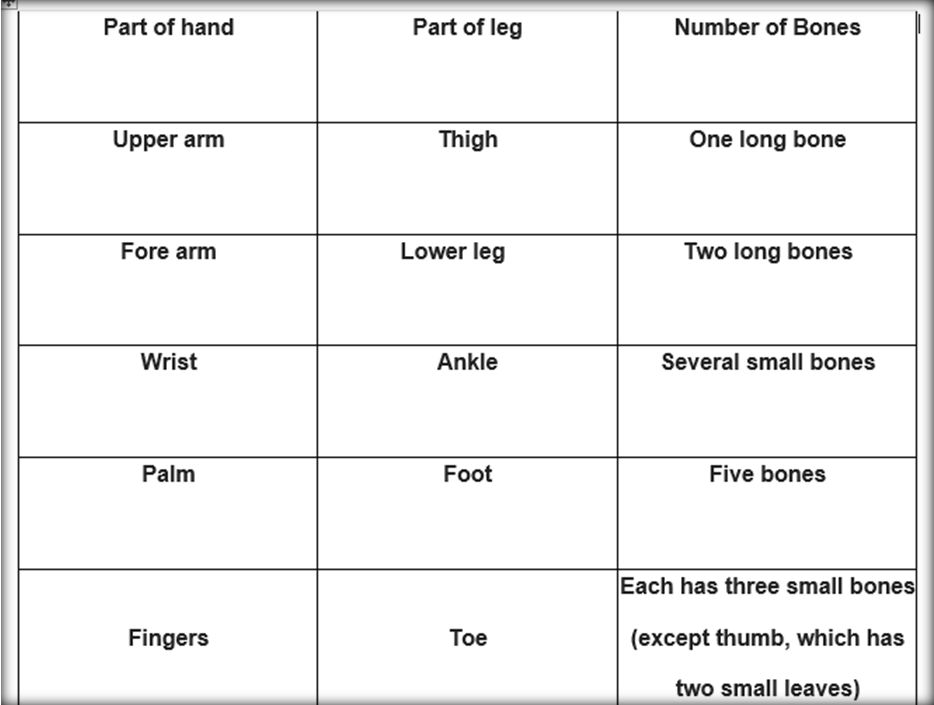
(i) Arms: Fore-arms is made up of two bones and hands have several small
bones. Shoulder bones have a pair of collar bones in front and a pair of
shoulder blades.
(ii) Legs: Lower leg is made up of two bones and feet have several small
bones. Hip bones or gridles bear weight of body and are attached to
thigh bones.
· Locomotion in other animals:
(i) Fish: Locomotion achieved by lateral contractions of the muscular body with a
final thrust by the tail. Fish swim by forming loops alternately on two sides of the body.
(ii) Birds: When the large flight muscles contract, they pull the wings down.
(iii) Snails: The muscular foot helps in locomotion.
(iv) Earthworms: Move by stretching out body in front and keeping the hind end fixed to the ground.
· The bones are moved by alternate contractions and relaxations of two sets of muscles.
· The bone joints are of various kinds depending on the nature of joints and direction of movement they allow.
· Strong muscles and light bones work together to help the birds fly. They fly by flapping their wings.
· Snakes slither on the ground by looping sideways. A large number of bones and associated muscles push the body forward.
· The body and legs of cockroaches have hard coverings forming an outer skeleton. The muscles of the breast connected with three pairs of legs and two pairs of wings help the cockroach to walk and fly.
Terms -
Limbs: The arms or legs of an animal.
Bones: These are the hard white structures below our skin that protect our internal organs. Bones are incapable of bending.
Joints: These are defined as the points at which two bones are fitted together. These are the points at which we can rotate and bend our bodies.
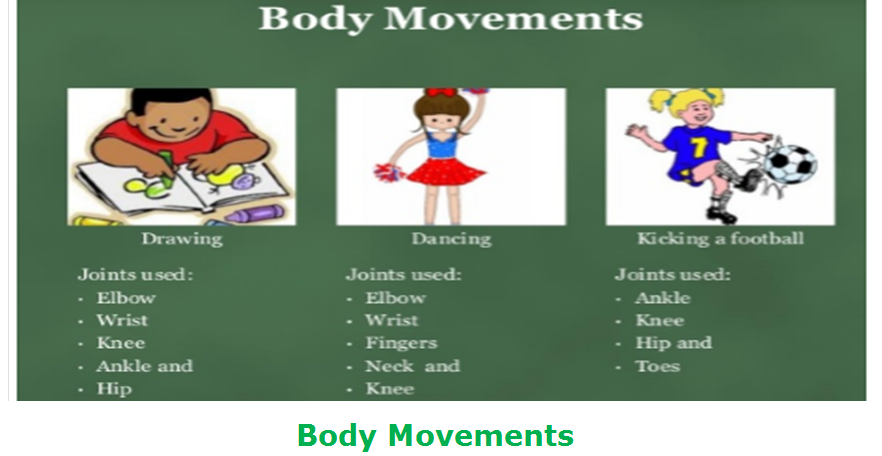
Joints
- Books Name
- Class 6 Science Book
- Publication
- PathSet Publications
- Course
- CBSE Class 6
- Subject
- Science
Joints
Joints: The point where two bones meet. Allow movement to take place. Bones are held together by ligaments.
(a) Movable Joints: It allows movement between bones and have cartilage
between them. Type of movable joints are:
(i) Hinge Joints: It allow movement only in one plane backwards and
forwards. Example: elbow joints, knee joints and joint between
phalanges of fingers and toes.
(ii) Ball and Socket Joints: It permit a circular movement. Example: the
shoulder.
(iii) Gliding Joints: It allow bones to slide a little. Example: bones inside
wrists and feet.
(iv) Pivotal Joints: Joint where the neck joins the head. It allows head to
move backward and forward and turn to right and left.
(b) Immovable or Fixed Joints: The bones cannot move at these joints. Example:
bones in skull, joint between upper jaw and rest of skull.
Types of Joints and their Location in Human Body
- A Pivot joint is a joint that rotates. Examples of pivot joints in the body in the neck that allows the head to rotate and the ones between the radius and ulna that allow forearm rotation.
- When bones can move along one axis, it indicates the presence of Hinge joint. e.g. Elbows and Knees.
- In the Ball and Socket joint, a partial spherical structure is present inside a socket allowing movement in all directions. e.g. hips and arms
- As the name suggests Fixed joint allows no movement to occur. e.g Skull
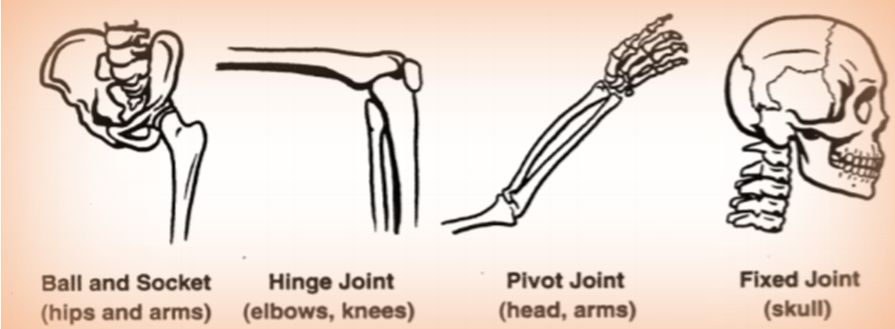
Figure 2: Types of Joints
Skeletal System
- Bones in our body form the framework that supports the whole body. This framework is called the skeleton.
- Our skeleton is made up of a number of bones and cartilages.
- There are about 650 muscles attached to the various bones in our body.
- The bones are hard and rigid.
- Cartilages are comparatively soft and elastic.
Functions of skeleton
- Skeleton system gives support to the body.
- It protects the inner organs.
- Together with muscles, it gives the body its shape.
- Red blood cells and some white blood cells are produced in the marrow of the bone.
Important Points to remember in a Human Skeleton:
- Bones provide support, protection, movement and perform several other functions.
- The bones in the skull (Cranium, Mandible, Maxilla) give protection to the brain.
- The long bones such as humerus, radius, ulna, tibia, fibula support the weight of body
- The carpals are located in wrist and tarsals are located in ankles. They are examples of short bones.
- The bones protecting the spine are called as the vertebral column. Cervical area (top 7 vertebrae), Thoracic (next 12), Lumbar (bottom 5 vertebrae), Sacrum (5 fused or stuck together bones) and Coccyx (the tiny bit at the bottom of the spine).
- The sternum and rib cage constitute the chest bones.
The skull: The skull has two main parts:
- Cranium: The bones of cranium are flat. They are held firmly like a zipper. It covers and protects the brain.
- Facial bones: The facial bones comprise the upper jaw, lower jaw and few other bones. The lower jaw is movable. The movement of lower jaw enables us to eat, talk and sing.
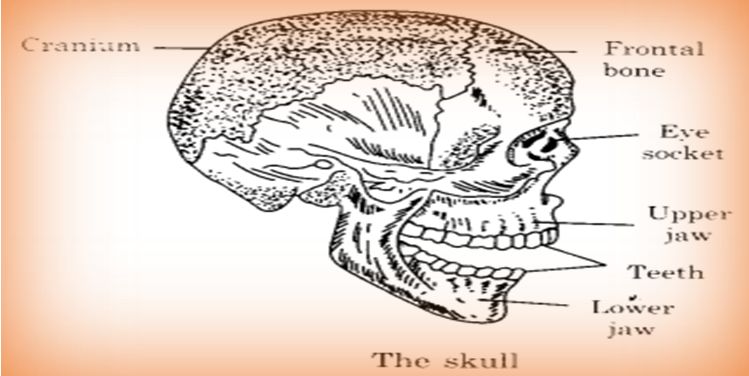
Eye sockets: The skull also includes a pair of eye sockets. These form a safe pocket for eyes.
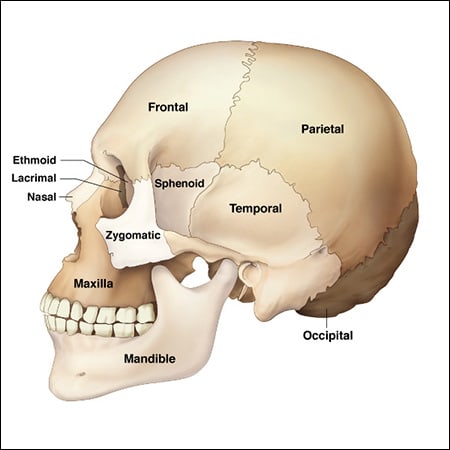
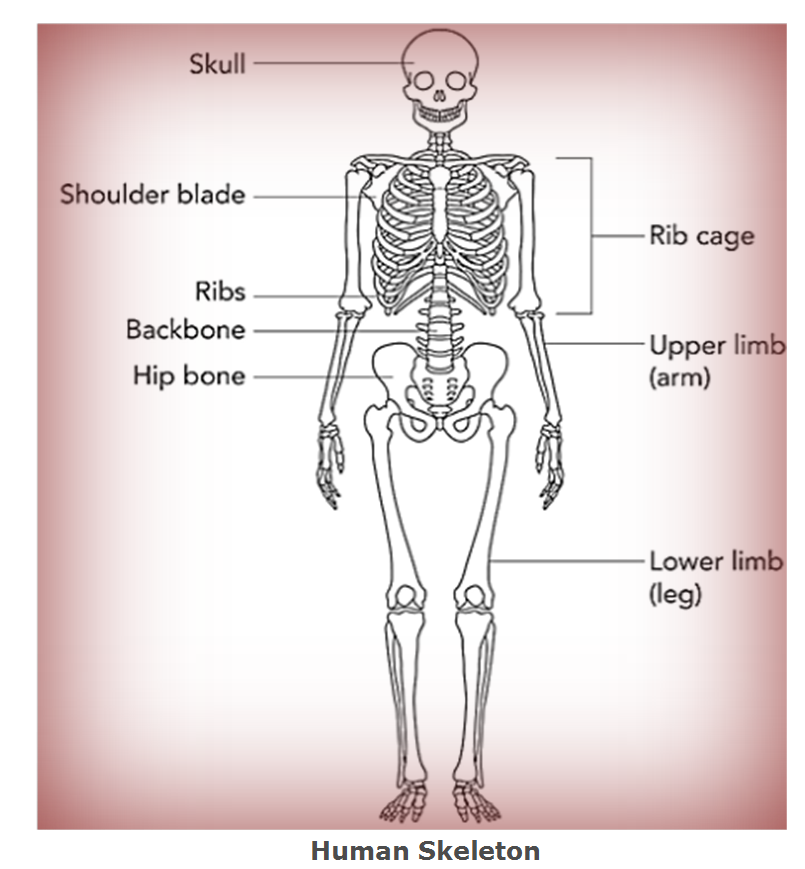
Some More Points to Remember

Gait of Animals
- Books Name
- Class 6 Science Book
- Publication
- PathSet Publications
- Course
- CBSE Class 6
- Subject
- Science
Gait of Animals
Some animals do not have bones. They have muscles which help to extend and shorten the body. During movement, animal first extends the front part of the body, keeping the rear position fixed to the ground. After that animal fixes the front end and releases the rear end. Now animal shortens the body and pulls the rear end forward. During this practice, animal moves forward by a small distance.
Rib cage: Ribs join with the chest bone and the backbone together to form a box. This is called rib cage.
1. Earthworm:
- Does not have bones
- Earthworm body is made up of rings
- A slimy substances secreted by its body aids movement (NSO)
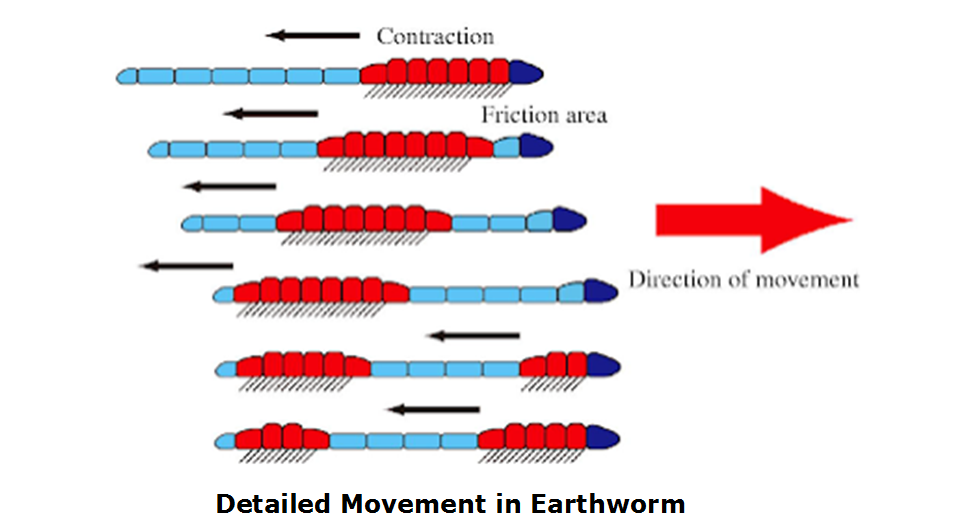
2. Snail:
- It has a slimy body, which does not have bones.
- The shell of the snail does not help in movement. It has to be carried along.
- The foot of the snail is a thick structure and is made up of strong muscles.
- A muscular organ called ‘Foot’ helps in locomotion.
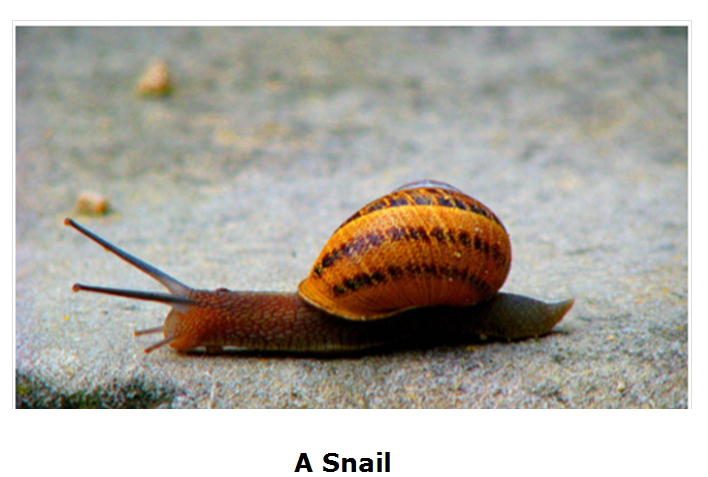
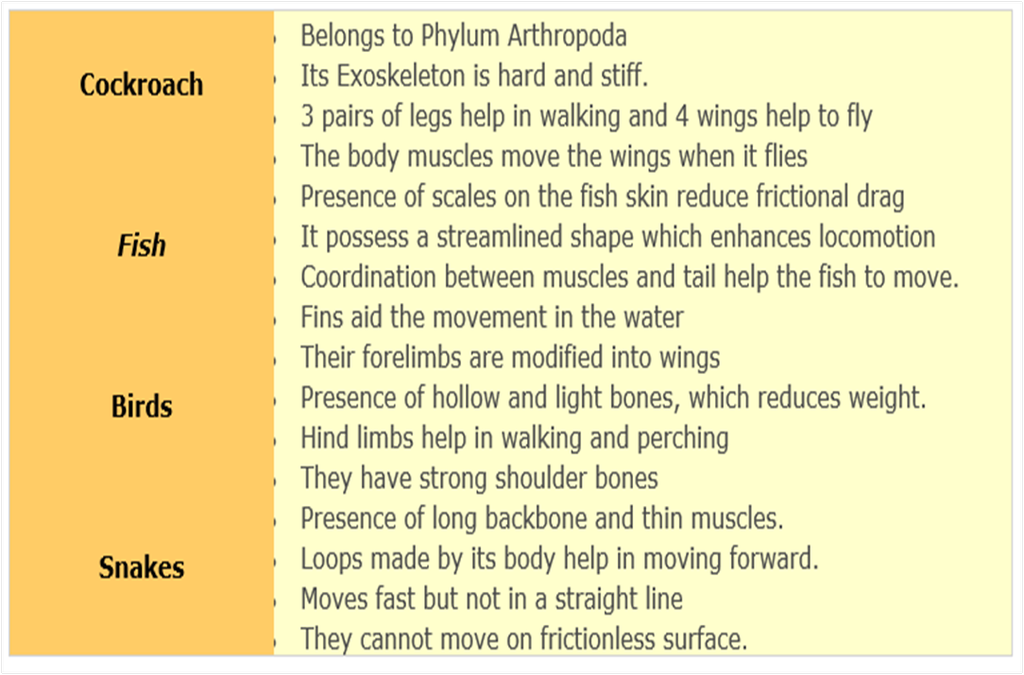
SUMMARY
Backbone: Backbone or vertebral column is composed of 33 small ring like bones called vertebrae. It is a hollow bony tube.
Ball and socket joint: A joint in which rounded end of one bone fits into the cavity of the other bones.
Bristles: Hair like structures projecting out of the body of earthworms. With the help of these, it fixes itself with the ground.
Cartilage: It is the additional part of the skeleton that is not as hard as the bones and which can be bent also.
Cavity: The bowl like part (hollow space) in the shoulder bone allows the rounded end of the arm bone to fit into it to form ball and socket joint.
Fixed joints: Some of the joints allow no movement. These are called fixed joints, e.g., joints in skull and upper jaw.
Hinge joint: Hinge joint is found in the fingers, elbow and knee. It allows movement only in one direction.
Muscle: Muscles are involved in the movement of bones.
Outer Skeleton: Skeleton found outside the body is called outer skeleton, e.g., hair and nails in human.
Pelvic bones: Bones in the hip region are called pelvic bones.
Pivotal joint: The joint where our neck joins the head is a pivotal joint.
Rib cage: Ribs join the chest bone and the backbone together to form a box. This is called rib cage.
Shoulder bones: The two bones of the shoulders are called shoulder bones.
Skeleton: The framework of the body which is made up of bones and cartilage is called skeleton.
Streamlined: The body shape where body tapers at both ends is called streamlined body, e.g., body of birds and fish.

 Param Publication
Param Publication
 PathSet Publications
PathSet Publications
